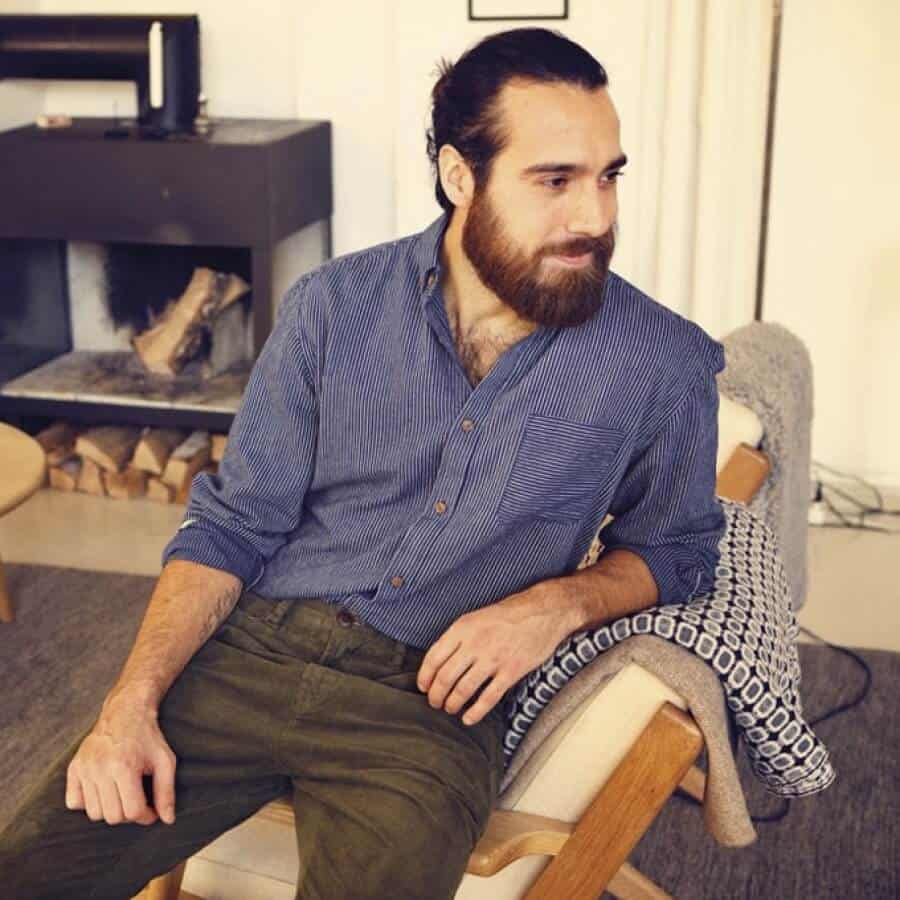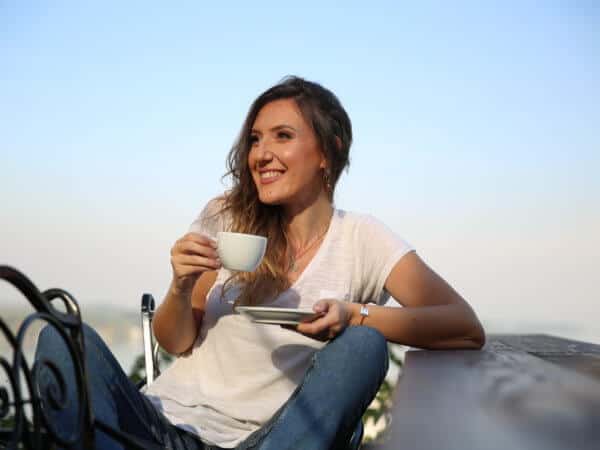He grew up looking up to a pilot father. He drew pictures of fighter planes and read books about heroic battles and dreamt of becoming a pilot himself – and so he did. After a while, he discovered beauty in catching moments with a camera lense, so he became a photographer. In the meantime, someone noticed his unique charm and offered him a job as a model. Today, the famous Swedish photographer and international model Christian Göran (33) shares everyday joys with his girlfriend and twin daughters traveling around Europe in an old, cramped camper - proving that dreams and reality can fit in the same box.
Christian, most people got to know something about you after the Trivago commercial was released. Yet, we don’t know much about your earlier life. Tell us, as the child of a Swedish father and a Chilean mother, was your childhood filled with traveling and discovering both Sweden and Latin America?
Since my father was a pilot I have traveled quite a bit going back as long as I remember. In the early years of my life we moved around within Sweden, depending on where my father got work as a newly licensed pilot without much experience. Unfortunately, we didn’t get to travel to South America too many times. It wasn’t until I was around 27 that I got a chance to go there again and really get to know my Chilean family. This was such a great experience for me. So much love. Now when I have kids myself I definitely want to go there one day and show them that part of their background.
As a kid, growing up in two different cultural backgrounds, what were the main values your parents taught you? Exactly how were you brought up?
I think my parents had a very relaxed attitude towards raising me. I never remember having many limits on what I could do. Therefore, I think I never felt I had to break any rules. The rebellious teenaged years never came for me. I was a complete computer nerd by the age of 14, building my own computers and writing setup scripts to tweak my gaming. I grew up in the countryside, so there was a lot of bicycling around during the summers to meet up with friends. Sweden is not so densely populated, so all my friends lived 10 km from each other. There was a lot of biking. If I look back at how they raised me I think the three qualities they valued the most were kindness, curiosity, and independent thinking.

You often say you felt like a kind of outsider. How come?
The reason for this was that I had a different cultural background. Where I grew up, very few people had parents who were not Swedish. None actually. This means my sense of humour, moral framework, and general social behaviour were partly different from the people I had around me in school and in my social life as I was growing up. I, in someways, was and therefore always felt a bit like an outsider. Being the odd bird.
Before doing photography, you were a pilot. When and why did you choose this profession in the first place?
As I mentioned before, my father was a pilot and I always looked up to him a lot. For as long as I can remember I dreamt of becoming a pilot myself. Always drawing pictures of fighter planes from the second world war. Building plastic models or Lego models, reading books about heroic pilots and battles. In the beginning of my teenaged years I remember sitting in a pilot’s jacket I inherited from my dad playing flight simulator computer games. I was obsessed!
A pilot’s job requires precision, accuracy, and huge responsibilities. The job of a photographer gives you complete freedom. How can you explain the interesting duality of your personality?
I am a person who seeks balance in different ways. I never liked digging myself into one thing and leaving other areas unexplored. By the age of 14 I flew gliders. On my 21st birthday I got my pilot’s license and began training for the MD80 jet turbine aircraft I was going to work on. With a big appetite for experience and renewal, I quickly felt that I had gotten where I wanted to get with flying after a few years of working as a commercial pilot.
At about age 25 I got into an art school I applied to, and there I found a more creative side of myself and also started doing photography. A side that was completely unexplored until then. I wanted a new challenge in life.

A lot of young people are afraid to follow their dreams because sometimes it simply costs them, literally. They can not do what they like, because it is not profitable, so they choose to do what it is more acceptable, struggling with the conflict between their dreams and reality. How did you overcome this issue, did you use your income from flying to fill in the gap until you started earning money from photography?
Yes, this is the sad fact of how our society is shaped today. Imagine if all of us could follow our interests and passions, dedicating our lives and creativity to projects we love! What an amazing world it would be. But unfortunately for most of us life is a battle between dreams and reality. I had the luck of quickly realising that my modelling was providing me more money and way more paid hours than my work as a pilot was. So I took the decision to work more as a model and use the spare time for refining my art as a photographer.
Without the modelling I think it would have been a longer process in which I would have continued working as a pilot while making a gradual transition to photography. Fortunately I had the luxury of making a clean break. Nothing comes easily, however. Patience and discipline take you where you want to be eventually.
In your photos we can see remarkable sequences from around the world. How often do you travel, and what are the criteria for the next destination?
I have always traveled frequently. In recent years the destinations have frequently entailed wave surfing and trekking. But lately I have started thinking that I want to explore Europe a bit more instead of flying to the other side of the planet. Mountain regions are where I want to spend some more time. I actually just bought an old camper from 1991, fixed it up a bit, and now I will go around Europe for a few months with my girlfriend and twin daughters. Spending time together while trekking, climbing, and surfing is the point.
You use both digital and analog cameras. Who taught you all the tricks?
I spent a lot of time online, learning digital photography first. How the camera works, getting a feeling for light and composition and also learning all the necessary computer programs properly. After a few years I got a job as an assistant. This boosted me from a hobby photographer into a professional photographer. Analog is also self taught. One of the amazing things about the internet is that if there is an interest in something, there are always youtube tutorials and voila! You can learn a lot today by yourself.

One of your mottos is „No lies just love“. How would you define love?
Wow, a deep, heavy question. Define love… Something that makes you want to stay through ups and downs. Through good times but most importantly the hard times. Love is not necessarily something you see in a movie, or read about in a poem. It is not the stormy passionate surface of the ocean but the ocean depths that stay the same through whatever happens on the surface.
You quit a well paid job in order to do what fulfills you. If you couldn’t earn a penny from photography, would you still take the same step?
To be honest, I am not earning a lot of money with my photography. It is a tough profession, and it takes many years to establish yourself. It is still a struggle. Sometimes when I go through financially hard times I can question myself and my choices. But I know that I will always be happy in the end to have made the decision to find out. To broaden my horizons.
“It’s better to regret something you did, than something you did not do,” is a quote I follow.
Again, patience and discipline take you where you want to be. With all the success stories you read about today in the media, it is easy to miss the fact that all successful people lived through a long list of failures before they ended up where they are now.
Now that you don’t have rosters and schedules and you do what you like, being your own boss, what does your average day look like?
When I have photoshoots I go where I will be taking the pictures. Otherwise I get up, eat my breakfast, and then I find a good, relaxing place to sit and take care of my e-mails, plan, and do photo editing on my lap top. After this I always try to take an hour to take care of myself and exercise. After that it is family and friends-time.
I also run an eco-resort in Indonesia that takes up quite a lot of time, so this is something I have to work with regularly, and I run a social media blog on Instagram which is connected to a Facebook account with followers. I actually get quite a lot of work as a photographer through these channels nowadays. Something I did not expect when I started it.
What is it that you would love to capture in your photos, but you still haven’t had a chance to do?
I still dream of meeting blue whales while diving. Getting eye contact with these magnificent beings and experiencing a sense of connection while taking photos of the encounter. Out in nature is where I want to be.
Photo: Christian Göran
Support us!
All your donations will be used to pay the magazine’s journalists and to support the ongoing costs of maintaining the site.
Share this post
Interested in co-operating with us?
We are open to co-operation from writers and businesses alike. You can reach us on our email at cooperations@youthtimemag.com/magazine@youthtimemag.com and we will get back to you as quick as we can.










